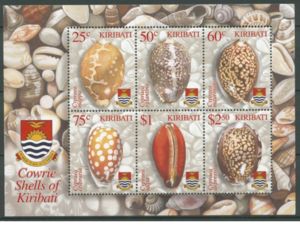Stamp Matters - Shell Money
In our culture, we have traditionally used metal coins as the basis for accumulating wealth and as a means of exchange for goods and services. It was fine if you had found a way of extracting metals from mined ore, but what was used before that? The answer for a large number of cultures was the shell. In isolated cases they are still used.

There are a number of properties that suitable shells had to have. They had to be reasonably plentiful, smallish in size, they had to be robust in structure, they had to be portable and in a lot of cases, pleasing to the eye. The most common shell to fall within these limitations is the cowrie shell. It is found in warm shallow seas in the Indian and south-western Pacific oceans. It is an inhabitant of the sandbanks close to shore which are exposed at low tides. The natives expose the shells at low tide and the creatures inside die quickly. The shells are collected, cleaned and dried, then are graded for size. Those which are oversize can be trimmed.
They are then threaded onto a length of native twine ready for use. In other areas a similar procedure is carried out with shells which have similar characteristics. Along the Pacific north-west coast of America tusk shells which were easy to thread together in strings up to 15 inches long. Further south in central and southern California the olive shell and the bivalve Saxidomus were used. The Iroquois and Algonquin tribes in inland eastern USA used the shell of the hard clam which was carved into beads. The beads were strung or used as decoration for belts. The money was called wampum.
In West Africa, the shining dwarf olive sea snail was used and the large land snail Achatina monetaria was cut into circles and threaded together. The cowrie was used in most of central and east Africa, and it became the currency of taxation. In Asia the cowrie was used in China from about 1000BC and the Chinese pictograph for money is a characterised cowrie shell. In India the cowrie shell was used until it was outlawed by the British East India Company. The ban led to a native uprising in 1817.
In Thailand, the cowrie still has an official value, 6400 cowries equal 1 baht. In Australia the pearl shell was used by some northern tribes, but it was not universal. The natives used to flake pieces off the inside of the shell to trade with other tribes. In the Solomon Islands, cowrie shells are still used locally and on New Britain they can be exchanged for the official currency, the kina. The ring cowrie was used in the Middle East. The cowrie shell appears on stamps of many countries, although the strings of shells are not illustrated yet. However, close examination of New Guinea dancers shows the use of shells as decoration adding to the value of the costume.


